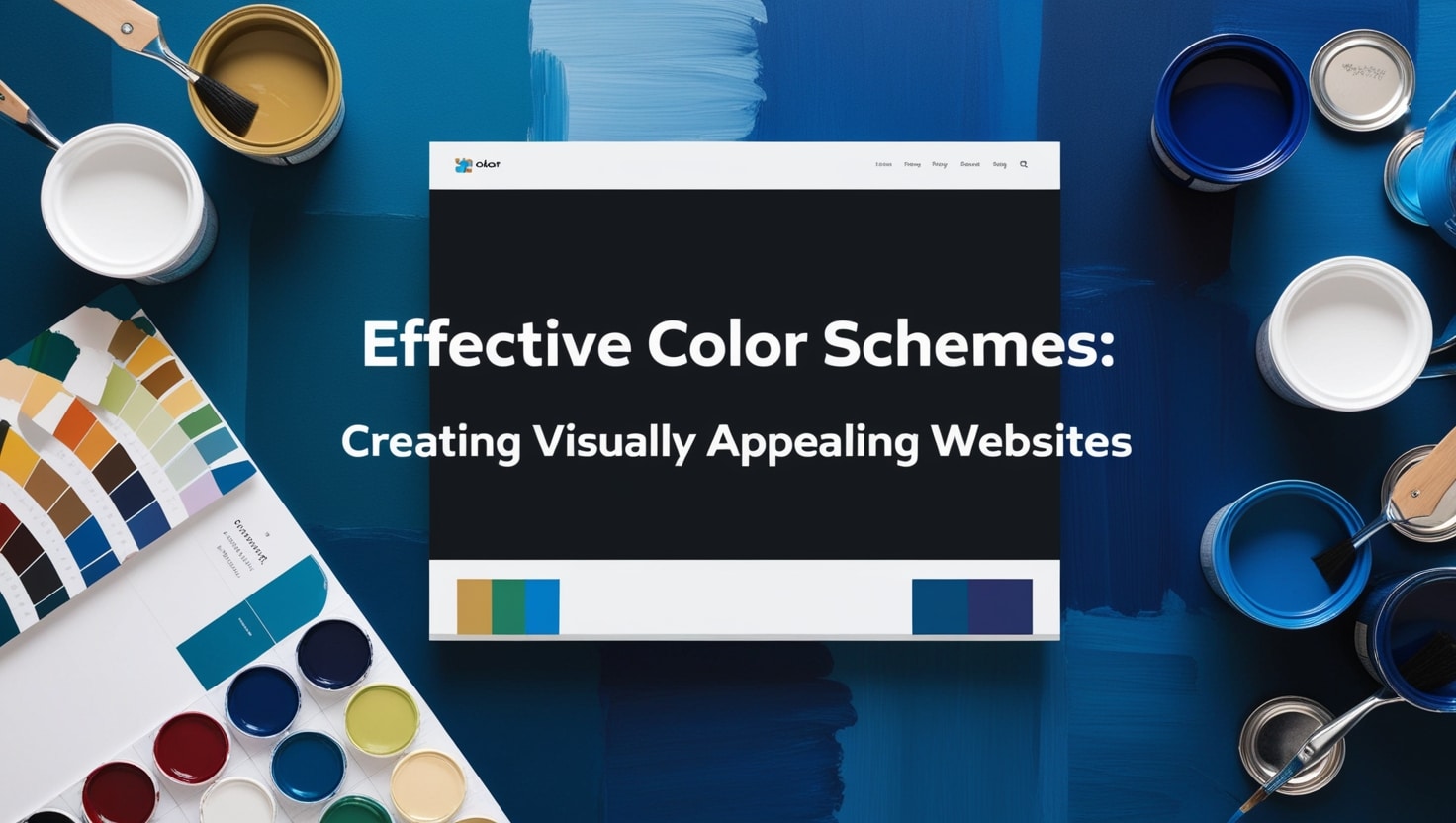Creating visually appealing websites with effective color schemes is crucial for web designers. Colour is one of the most powerful tools at a designer’s disposal. It can evoke emotions, convey messages, and influence users’ behaviour. Colour can either make or break a website. Choosing the right colour scheme is essential for creating a visually stunning website that engages users and keeps them coming back.
Colour is an essential aspect of web design. Colour combinations can affect the overall message of a website. Research has shown that some colours are more aesthetically pleasing than others. For example, blue colour schemes are more calming and soothing, while red is more stimulating and energizing. Understanding the psychology of colour can help designers create an effective colour scheme that resonates with the target audience.
Effective use of colour can increase conversion rates, improve user experience, and enhance brand recognition. Colour can be used to guide users through a website, highlight important information, and create a sense of hierarchy. A well-designed colour scheme can also convey the brand’s personality and values. By creating a visually appealing website with an effective colour scheme, designers can improve user engagement and create a positive impression of the brand.
Understanding the Basics of Colour in Web Design
Colour is an essential element of web design that can either make or break a website’s visual appeal. Understanding the basics of colour in web design is crucial for creating visually appealing websites with effective colour schemes.
Designers must have a good understanding of colour theory and the psychology of colour to create a website that resonates with the target audience. Colour theory involves the study of how colours interact with each other and how they can be combined to create visually appealing designs.
The colour scheme is the set of colours used in a website’s design, including the background, text, and other elements. A well-designed colour scheme can help to establish a brand identity, convey a message, and create a mood or tone.
There are various types of colour schemes, including monochromatic, analogous, complementary, and triadic. A monochromatic colour scheme uses different shades of the same hue, while an analogous colour scheme uses colours that are adjacent to each other on the colour wheel. A complementary colour scheme uses colours that are opposite each other on the colour wheel, while a triadic colour scheme uses three colours that are evenly spaced on the colour wheel.
The use of colour can also affect the user experience of a website. For example, high contrast between the background and text can improve readability, while low contrast can make it difficult to read. The use of vibrant colours can grab the user’s attention and create a sense of excitement, while muted colours can create a more sophisticated and elegant look.
It is also important to consider the brand identity and personality when selecting a colour scheme. For example, a brand that wants to convey trust and professionalism may use blue, while a brand that wants to be seen as youthful and energetic may use bright colours such as pink or lime green.
Overall, understanding the basics of colour in web design is crucial for creating visually appealing websites with effective colour schemes. Designers must consider the brand identity, target audience, and user experience when selecting a colour scheme and must have a good understanding of colour theory and the psychology of colour.
Applying Colour Theory to Website Design
Colour theory is an essential aspect of web design. It is the study of how colours interact with each other and how they can be used to create visually appealing designs. By understanding colour theory, web designers can create effective colour schemes that enhance the user experience.
Colour wheel
The colour wheel is a tool that web designers use to create colour schemes. It is a visual representation of the primary, secondary, and tertiary colours. The primary colours are red, blue, and yellow, and they cannot be created by mixing other colours. The secondary colours are green, orange, and purple, and they are created by mixing two primary colours. Tertiary colours are created by mixing a primary and secondary colour.
Colour combinations
Web designers use different colour combinations to create visually appealing designs. Some popular colour combinations include complementary, analogous, and monochromatic. Complementary colours are opposite each other on the colour wheel and create a high contrast effect. Analogous colours are adjacent to each other on the colour wheel and create a harmonious effect. Monochromatic colours are different shades of the same colour and create a calming effect.
Base colours and accent colours
Web designers use base colours and accent colours to create a balanced colour scheme. Base colours are the primary colours used in the design, while accent colours are used to add contrast and visual interest. Bold and bright colours are often used as accent colours, while neutral and pastel colours are used as base colours.
Vibrant colours
Vibrant colours are bright and bold and are often used to create an eye-catching design. They can be used as accent colours or as the base colour for the design. However, it is important to use vibrant colours sparingly, as they can be overwhelming if overused.
Neutral colours
Neutral colours are muted and subtle and are often used as base colours in a design. They create a calming effect and allow the accent colours to stand out. Some popular neutral colours include white, grey, and beige.
By applying colour theory to website design, web designers can create visually appealing designs that enhance the user experience. The use of colour combinations, base colours and accent colours, vibrant colours, and neutral colours can create a balanced and effective colour scheme.
Influence of Colour on Branding and Audience Perception
Colour plays a significant role in creating visually appealing websites with effective color schemes. It can enhance the brand identity, recognition, and perception of a website. The right use of colours can create a positive impression on the audience and evoke emotions such as trust, sophistication, youthfulness, and eco-friendliness.
Brand recognition is one of the most important aspects of branding. The use of consistent colours across all marketing channels can help improve brand recognition. For example, Coca-Cola’s red and white colour scheme is instantly recognisable worldwide. Similarly, the use of specific colours in logos and branding materials can help create a strong brand identity.
Colour psychology is an essential factor that influences the audience’s perception of a brand. Colours can evoke different emotions and associations in people. For instance, blue is often associated with trust, while green is associated with eco-friendliness. By understanding the psychology behind colours, website designers can choose the right colours to create a specific mood or emotion.
The message and values of a brand can also be conveyed through the use of colours. For example, the use of green and eco-friendly colours can highlight a brand’s commitment to sustainability. Similarly, the use of bold and vibrant colours can convey a brand’s personality and values.
In conclusion, the right use of colours can significantly impact a website’s branding and audience perception. By understanding the psychology behind colours, website designers can create visually appealing websites with effective colour schemes that can enhance a brand’s identity, recognition, and perception.
Colour and Website Accessibility
When designing a website, it is important to consider the accessibility of the colour scheme. Accessibility refers to the ability of all users, including those with disabilities, to access and use a website. One important aspect of accessibility is readability, which can be affected by the contrast between text and background colours.
To ensure readability, designers should choose colours with sufficient contrast. This can be achieved by using colour codes that meet the Web Content Accessibility Guidelines (WCAG) 2.1 Contrast Ratio requirements. For example, black text on a white background has a high contrast ratio, making it easy to read. Similarly, dark green text on a lime green background has a low contrast ratio, making it difficult to read.
Another factor to consider is the amount of white space on a page. White space, or the empty space between design elements, can help to improve readability and make a website more visually appealing.
Designers should also consider the size of text and other design elements. Text should be large enough to be easily read, and other design elements should be appropriately sized to ensure they are visible and easy to interact with.
When designing a colour scheme, designers should consider whether it is appropriate for the content and purpose of the website. For example, a black and white colour scheme may be appropriate for a minimalist website, while a grey colour scheme may be appropriate for a professional website.
In conclusion, when designing a website, it is important to consider the accessibility of the colour scheme. Designers should choose colours with sufficient contrast, ensure there is enough white space, and appropriately size design elements to ensure readability and usability for all users.
Optimising Colour for User Experience and Engagement
Colour plays a crucial role in creating visually appealing websites with effective color schemes. The right colour combination can help website visitors stay engaged, improve user experience, and drive conversions. In this section, we will explore how to optimise colour for user experience and engagement.
Understanding User Experience
User experience (UX) is the overall experience a user has when interacting with a website. Colour can have a significant impact on user experience. For example, a website with a poor colour scheme can be difficult to navigate, causing frustration and driving visitors away. On the other hand, a website with a well-designed colour scheme can be inviting and engaging, keeping visitors on the site for longer.
Engaging Website Visitors
Engagement is critical for any website. The longer a user stays on a website, the more likely they are to convert. Colour can help to keep users engaged by drawing attention to important elements such as icons, buttons, and calls to action. For example, using a contrasting colour for a call to action button can make it stand out and encourage users to click.
Traffic and User Interface
Colour can also affect traffic and user interface. A website with a poor colour scheme can be difficult to navigate, causing visitors to leave and increasing bounce rates. On the other hand, a website with a well-designed colour scheme can be easy to navigate, encouraging visitors to explore the site and reducing bounce rates.
Conversion and Attention
Conversion is the ultimate goal of any website. Colour can play a significant role in driving conversions. For example, using a contrasting colour for a call to action button can draw attention to it and encourage users to click. Similarly, using a warm colour such as red or orange for a limited time offer can create a sense of urgency and encourage users to take action.
Website Builder and Facebook
Website builders such as Wix and Squarespace offer a range of colour schemes that can be used to create visually appealing websites. Similarly, Facebook offers a range of colour schemes that can be used to create engaging pages. However, it is important to choose the right colour scheme for your brand and target audience to ensure maximum impact.
In conclusion, optimising colour for user experience and engagement is essential for creating visually appealing websites with effective colour schemes. By understanding user experience, engaging website visitors, improving traffic and user interface, driving conversions and attention, and utilising website builders and Facebook, you can create a website that stands out and drives results.
Case Study: Successful Colour Schemes in Popular Websites
When it comes to creating visually appealing websites, choosing the right colour scheme is crucial. A well-planned and executed colour scheme can enhance the overall look and feel of a website, and can even influence the behaviour of its visitors. In this section, we will explore some successful colour schemes used by popular websites.
Facebook’s colour scheme is a classic example of a successful website colour scheme. The blue and white colour palette is simple, yet effective, and has become synonymous with the brand. The blue colour is calming and trustworthy, which is important for a social media platform that handles a lot of personal information.
Airbnb
Airbnb uses a warm and inviting colour scheme that is perfect for a website that offers accommodation. The colour palette consists of shades of orange, red, and yellow, which are associated with warmth, comfort, and happiness. The use of these colours makes the website feel welcoming and encourages visitors to explore the site further.
Squarespace
Squarespace is a website builder that is known for its sleek and modern designs. The colour scheme used on its website reflects this aesthetic, with a monochromatic palette of black, white, and grey. This colour scheme is perfect for a website that is focused on design and allows the content to take centre stage.
Website Visitors
When choosing a colour scheme for a website, it is important to consider the preferences of the target audience. For example, if the website is aimed at a younger demographic, it may be appropriate to use bright and bold colours. On the other hand, if the website is aimed at a more mature audience, a more subdued colour palette may be more appropriate.
Website Design
The design of a website should also be taken into consideration when choosing a colour scheme. For example, a minimalist website may benefit from a monochromatic colour scheme, while a website with a lot of content may benefit from a more varied colour palette.
In conclusion, choosing the right colour scheme is an important part of creating a visually appealing website. By taking into consideration the preferences of the target audience and the design of the website, it is possible to create a colour scheme that enhances the overall look and feel of the site.
Conclusion
In conclusion, the impact of colour schemes on website design has been well documented. The use of effective colour schemes can significantly improve a website’s visual appeal and user experience.
It is important to note that the choice of colour schemes should be based on the target audience and the website’s purpose. For example, a website targeting children may use bright and bold colours, while a website targeting professionals may use more muted and sophisticated colours.
Furthermore, the use of complementary colours can enhance the website’s overall aesthetic appeal. Complementary colours are those that are opposite each other on the colour wheel, such as blue and orange or red and green.
It is also important to consider the accessibility of the website for users with visual impairments. Using high contrast colours and avoiding colour combinations that can cause issues for colour-blind users is crucial for ensuring inclusivity.
In summary, when creating visually appealing websites with effective colour schemes, designers should consider the target audience, purpose, complementary colours, and accessibility for all users. By following these guidelines, designers can create websites that are both aesthetically pleasing and functional.







